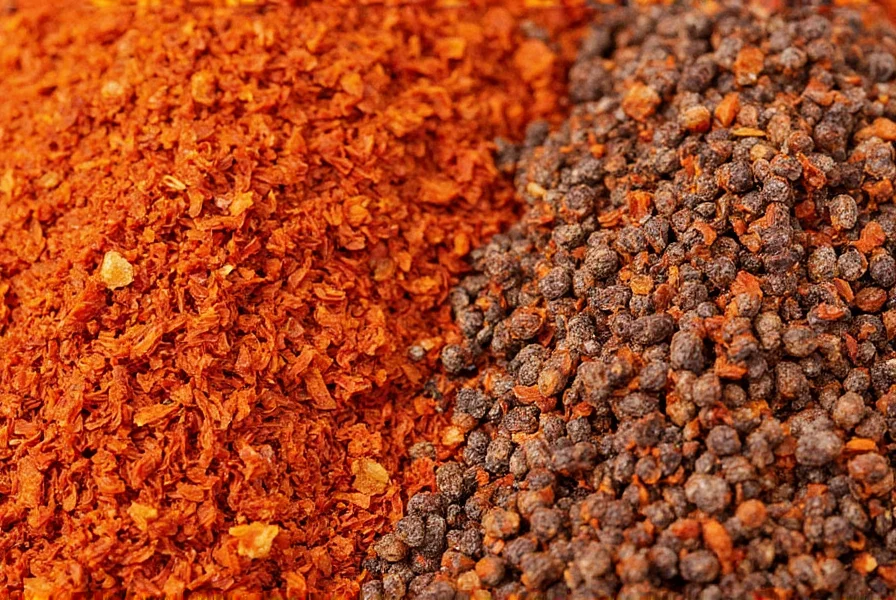Aleppo pepper, known as halaby pepper in its native Syria, has become a staple in Mediterranean and Middle Eastern cooking. This sun-dried, crumbled chili offers a distinctive flavor profile that's challenging to replicate exactly. When your recipe calls for Aleppo pepper but you're out of stock, understanding the right substitution becomes crucial for maintaining authentic taste.
Understanding Aleppo Pepper's Unique Profile
Aleppo pepper (Capsicum annuum) originates from the Aleppo region of Syria. Unlike standard red pepper flakes, it undergoes a specific curing process where peppers are:
- Sun-dried for several weeks
- Tossed with olive oil and salt
- Crumbled into coarse flakes
This process creates a complex flavor with moderate heat (about 10,000 Scoville units), fruity undertones, and a subtle saltiness. The texture is coarser than standard red pepper flakes, providing both flavor and visual appeal to dishes.
Top 5 Aleppo Pepper Substitutes Ranked
Not all substitutes work equally well across different applications. Here's how common alternatives compare:
| Substitute | Heat Level | Flavor Match | Best Ratio | Ideal For |
|---|---|---|---|---|
| Urfa Biber | Medium | ★★★★☆ | 1:1 | Middle Eastern dishes, grilled meats |
| Paprika + Cayenne | Medium | ★★★☆☆ | 3:1 | General cooking, sauces, dressings |
| Maras Pepper | Medium-Low | ★★★☆☆ | 1:1 | Vegetable dishes, dips |
| Crushed Red Pepper | High | ★☆☆☆☆ | 1:2 | Pizza, pasta, quick fixes |
| Chipotle Powder | Medium | ★☆☆☆☆ | 1:1.5 | Mexican fusion, hearty stews |
Detailed Substitute Analysis
1. Urfa Biber (Best Authentic Alternative)
This Turkish pepper shares Aleppo's production method—sun-dried and cured in brine. Urfa biber offers similar moderate heat with distinctive smoky, raisin-like notes. The main difference is Urfa's slightly darker color and more pronounced smokiness. Use it as a 1:1 replacement in kebabs, eggplant dishes, and olive oil infusions.

2. Paprika and Cayenne Blend (Most Accessible Option)
For cooks without specialty ingredients, combine:
- 3 parts sweet Hungarian paprika (provides fruitiness)
- 1 part cayenne pepper (adds heat)
- Pinch of flaky sea salt (mimics cured texture)
This blend works particularly well in:
- Marinades for chicken or lamb
- Tzatziki and other yogurt-based sauces
- Roasted vegetable seasoning
3. Maras Pepper (Fruity Alternative)
Hailing from Turkey's Maras region, this pepper delivers Aleppo's fruitiness with slightly less heat. Its vibrant red color makes it visually similar. Maras pepper excels in dishes where appearance matters, like:
- Hummus and baba ghanoush
- Tomato-based sauces
- Flatbreads and pizza
When Substitutions Fail: Critical Considerations
Certain dishes absolutely require authentic Aleppo pepper. Avoid substitutions in:
- Traditional Syrian muhammara (walnut-red pepper dip)
- Levantine za'atar blends where Aleppo is a key component
- High-end restaurant recipes specifying Aleppo by name
For these applications, seek authentic sources. Many Middle Eastern markets and online specialty retailers now carry genuine Aleppo pepper despite supply chain challenges from the Syrian conflict.
Practical Substitution Guide by Dish Type
Different culinary applications demand tailored approaches. Follow these recommendations for best results:
| Dish Type | Recommended Substitute | Adjustment Tips |
|---|---|---|
| Mediterranean salads | Maras pepper | Reduce by 25% to prevent overpowering fresh ingredients |
| Meat marinades | Urfa biber | Add 1 tsp lemon juice to enhance fruitiness |
| Pasta sauces | Paprika-cayenne blend | Bloom in olive oil before adding to sauce |
| Roasted vegetables | Crushed red pepper | Soak in warm water for 10 minutes to reduce harshness |
Where to Find Quality Substitutes
Most grocery stores now carry suitable alternatives. Check these sections:
- International aisle: Look for Turkish or Middle Eastern specialty products
- Spice section: Premium paprika varieties often sit near standard options
- Online retailers: Search for "Urfa biber" or "Maras pepper" from reputable spice companies
Avoid generic "red pepper flakes" from the Italian section—they lack Aleppo's nuanced flavor profile and tend to be significantly hotter.

Common Substitution Mistakes to Avoid
Even experienced cooks make these errors when replacing Aleppo pepper:
- Using equal amounts of standard red pepper flakes—they're typically twice as hot
- Ignoring the salt component—authentic Aleppo includes salt in its curing process
- Adding substitutes too late—Aleppo's flavor develops when bloomed in oil early in cooking
- Overcompensating for heat—Aleppo's moderate heat is part of its appeal; don't eliminate all spiciness
Creating Your Own Aleppo-Style Blend
For the most authentic experience, make your own version when genuine Aleppo pepper is unavailable:
- Combine 1 cup mild paprika, 1/4 cup cayenne, and 2 tsp flaky sea salt
- Add 1 tsp smoked paprika for depth (optional)
- Mix with 2 tbsp olive oil to create a paste
- Spread on parchment paper and dry in oven at lowest setting for 2 hours
- Crumble and store in airtight container
This DIY approach captures Aleppo pepper's essential characteristics while allowing customization for personal heat preferences.











 浙公网安备
33010002000092号
浙公网安备
33010002000092号 浙B2-20120091-4
浙B2-20120091-4